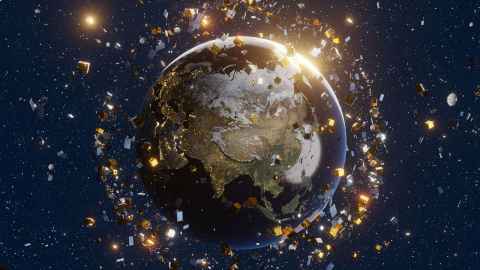Global agreement needed to curb orbital pollution
15 January 2025
Analysis: University of Auckland experts Dr Thomas Dowling and Te Kahuratai Moko-Painting provided New Zealand perspectives to a global initiative calling for sustainable development in space.

The number of satellites and other objects sent into Earth’s orbit is increasing like never before. Before space ends up awash with debris like the ocean, scientists are calling for global agreements to protect orbital space.
The United States and China are in a space race, sending thousands of satellites into orbit every year. More than 95 nations and corporations have joined the race to exploit the orbital environment.
Parallels can be drawn between Earth’s orbit and our oceans. While coastal waters are managed as national resources, much of the ocean is regarded as an international commons. So is space. The dark side of these environments being regarded as international commons is that shared resources are easily over-exploited. Our oceans have suffered the tragedy of the commons, and Earth’s orbit faces the same threat.
Our oceans were once regarded as near-infinite resources to plunder and as sinks for our waste. We now know that view was grossly mistaken - many marine environments are barren wastelands, and more than eight million tonnes of plastic debris are estimated to enter the ocean every year. An estimated 170 trillion plastic particles are currently afloat.
Mindlessly exploiting the orbital environment is repeating the mistakes of the past. A global approach is required, including international legislation focused on protecting Earth’s orbital environment.
New Zealand and the Pacific have much to lose unless waste in space is managed more responsibly. New Zealand has darker skies than many countries around the world, making stars visible that are sacred within Māori culture. Many New Zealanders and expert astronomers treasure our dark skies dotted with stars and planets. But our night skies have been fundamentally altered. We can now see satellites twinkling among the seven sisters of the Matariki cluster.
The United States, Europe, China and other northern hemisphere space powers regard the Pacific as the ideal ‘uninhabited’ dumping ground for spacecraft removed from Earth’s orbit. This only shifts the problem. Toxic hydrazine fuels from obsolete and downed spacecraft are polluting Pacific seas.
The World Health Organisation has classified hydrazine as a possible cancer-causing environmental contaminant. While more research is needed to understand the impact on marine environments, we know hydrazine is hazardous.

Common low earth orbits are already packed with satellites, rocket bodies and stray chunks of metal.
Space is infinite, but the useful orbital ‘shell’ of our planet is limited. Common low earth orbits are already packed with satellites, rocket bodies and stray chunks of metal.
The European Space Agency Space Debris Office estimated in 2022, that more than 14,700 satellites had been launched into Earth’s orbit since Sputnik-1 in 1957. About 9,780 remain in orbit, with a total mass greater than 10,500 tonnes, but only about 6,900 are operational.
Over the past five years, mega-constellations of satellites to provide broadband internet have been launched into the lower earth orbit, with an altitude of up to 2,000km. For example, SpaceX’s Starlink plans to put as many as 42,000 satellites in orbit. That’s more new satellites than existing trackable debris. By 2022, 3271 of these satellites had been launched in narrow orbital shells, causing unprecedented congestion.
Most satellites in lower Earth orbit have a lifespan of about five years. They need to be constantly replaced – and disposed of. As they re-enter the atmosphere, satellites burn and are destroyed. But this only transfers the problem, injecting black carbon and tiny particles of aluminium into the atmosphere
None of this should surprise us. In 1978, NASA scientists Donald Kessler and Burton Cour-Palais posited a scenario in which space pollution in the lower Earth orbit became so dense that collisions between objects could cause a domino effect - each collision would generate more debris, increasing the likelihood of further collisions.
This is the Kessler syndrome, and one implication is that Earth’s orbit might be rendered useless for satellites and other technologies, because a cascade of collisions are inevitable.
There is no international agreement to prevent the onset of Kessler syndrome. Efforts have been made through the US Artemis Accords, the European Space Agency’s Zero Debris Charter and other agreements, but they have not been ratified by all nations and lack robust enforcement.
Our team of scientists and experts recommends a global treaty is adopted internationally to protect Earth’s orbit. Effective enforcement will be crucial to safeguard this most global of commons.

We need to ensure objects entering orbit are safe, sustainable, and that they serve essential – or at least important – purposes for significant numbers of people around the world. We need to start reducing, reusing, recycling, and recovering objects in space.
Organisations that produce and send objects into orbit need to be held responsible for what they create over an extended period. Incentives could be offered to encourage innovative solutions to prevent and remove orbital debris.
One solution we propose is the development of a new United Nations Sustainable Development Goal to protect Earth’s orbit, in the same way Goal 14 protects the marine environment. While the 17 Sustainable Development Goals are non-binding, they have influenced global debates, policy agendas, and institutional priorities. We wish plastic pollution in our oceans had been curbed decades ago. There is still time to protect space.
University of Auckland lecturer in Te Pūnaha Ātea - Space Institute, Dr Thomas Dowling, from Ngā Ara Whetū Centre for Climate, Biodiversity and Society, and University co-director of Te Pūtahi o Pūtaiao and indigenous astronomy expert Te Kahuratai Moko-Painting offered New Zealand perspectives for the paper Applying Lessons from the Ocean for the Sustainable Development in Space, in One Earth journal.
This article was first published on Newsroom.
Media contact: mediateam@auckland.ac.nz